This post may contain paid links. See more info on my privacy page.
If you're a fan of rich and bold flavors, then you must try my Red Wine Reduction Sauce recipe! This easy red wine sauce adds depth and sophistication to any steak dinner, elevating the average to steakhouse quality. Plus, it's easy to make in less than 10 minutes!
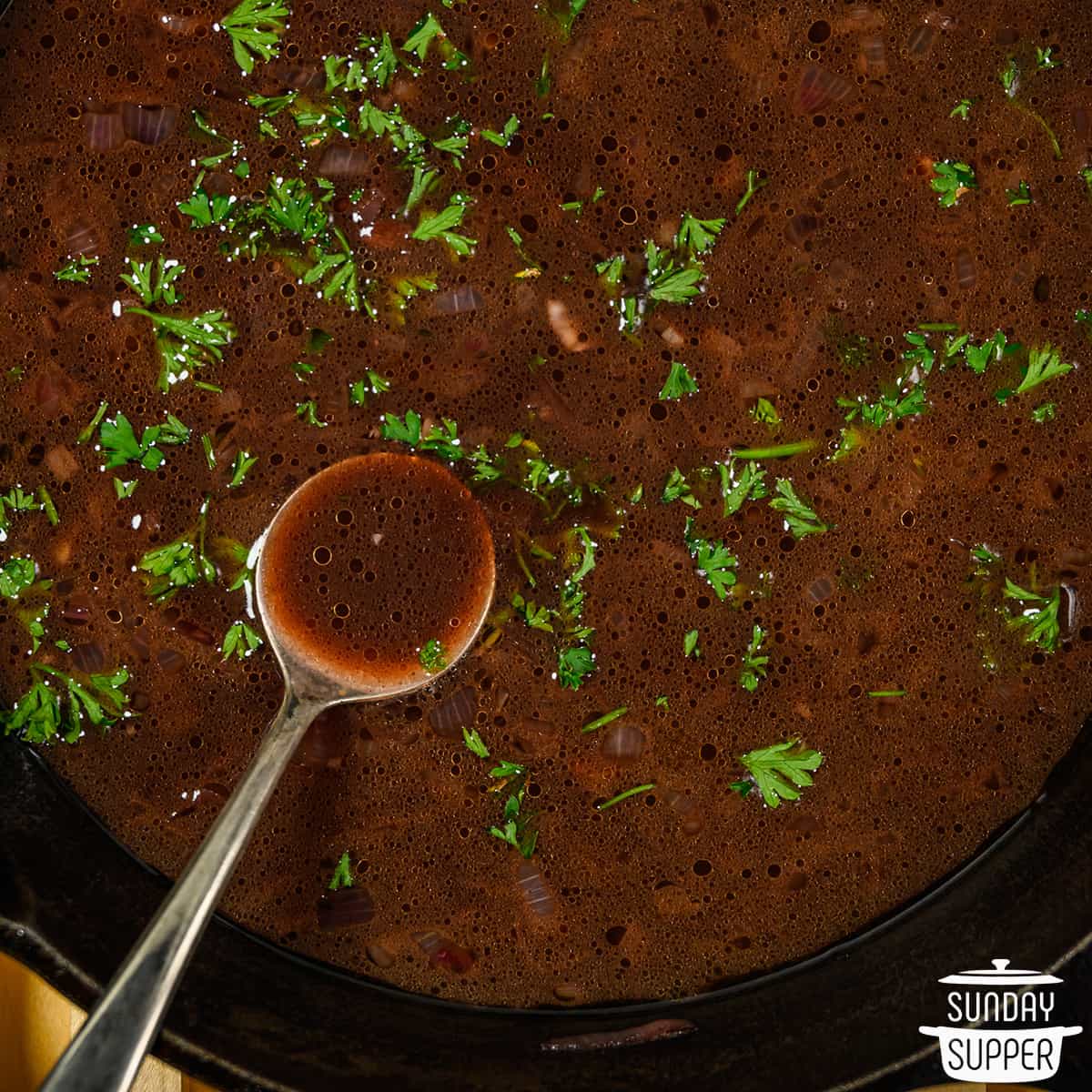
Jump to:
Red Wine Reduction
Whether you're pan-searing a juicy ribeye or a tender filet mignon, this red wine reduction sauce is just what you need to elevate the meal. It captures those delectable pan drippings and infuses them with the flavors of red wine, garlic, shallots, and fresh herbs, for a heavenly match with steak.
Luscious, velvety red wine sauce has long been a favorite of mine, and whenever I make it, I get asked for the secret. Don't worry: it's much easier than you might think, combining simple ingredients with a short cook time. Plus, you can prepare it in the same pan you made your steak in, so you escape having to do more dishes.
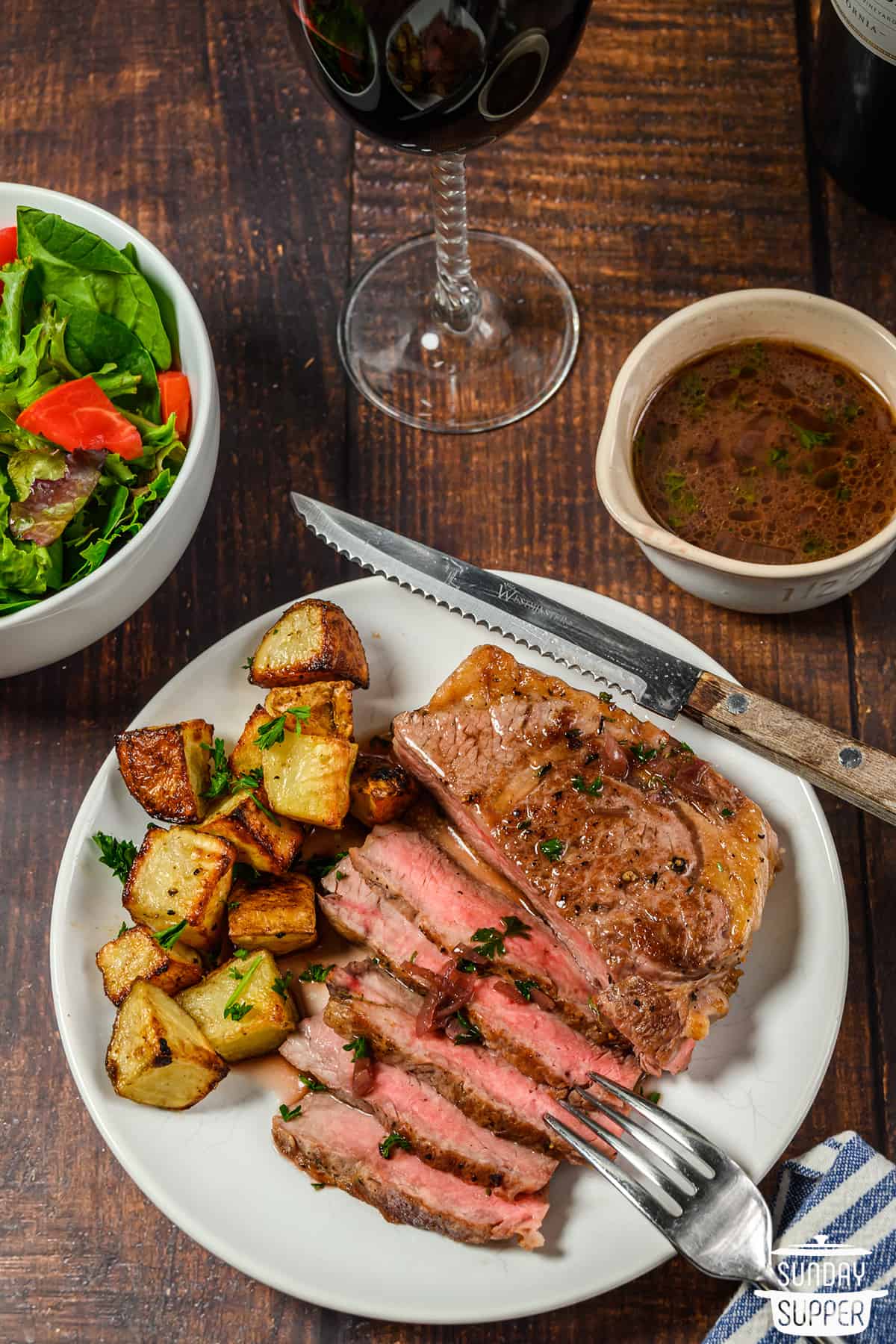
Best Wines for Red Wine Reduction
Your choice of wine can influence the taste of your red wine sauce, so I recommend choosing one based on the flavors you want to achieve. Here are some options to consider:
- Full-bodied reds, such as Petite Sirah, Syrah, or Duoro. These wines vary in flavor, but many contain notes of cherry, currants, and plum, for a rich and fruity taste.
- Dry red wines, such as Cabernet Sauvignon, Merlot, Carbernet Franc, and Malbec. These wines often contain notes of peppery, warm notes that give the wine a slightly spicy flavor, although some are sweeter.
- Light red wines, such as Pinot Noir, Cinsault, Grenache, Gamay, Zinfandel, or St Laurent. These are light-bodied wines that offer a variety of flavor profiles, but with a lighter mouthfeel than other wines.
To choose the best wine for your red wine sauce, pick your usual favorite or, if you don't have one, go by the flavor profile described by the bottle and choose based on the taste and feel you want your sauce to have.
Alternatively, you can use beef stock or an alcohol-free red wine, if you prefer to not use alcohol.
Wine Reduction Sauce Ingredients
- Steak Pan Drippings: If you don't have fresh pan drippings from steak, you can substitute additional butter.
- Garlic: I use garlic paste for the convenience, but you can also use fresh minced garlic.
- Shallots: Minced. Or, use minced red onions.
- Red Wine: If you don't want to use alcohol, you can still make this red wine reduction - it will just taste slightly different. Use additional beef stock in place of red wine.
- Balsamic Vinegar: This is a key ingredient to achieving the best flavor with your red wine reduction.
- Thyme: You can use fresh or dried thyme. Always use less when using dried herbs.
- Beef Stock: If broth is what you have, you can use beef broth, too.
- Parsley: I recommend fresh parsley for garnish, but you can leave it out if you like.
- Butter: I recommend unsalted butter, but you can use salted butter. Just be sure to adjust the seasoning to your taste if using salted.
Other herbs, such as rosemary, can also be used for flavor, if you wish.
Although you can use butter in place of drippings, red wine reduction sauce is best when made with fresh pan drippings. Those browned bits at the bottom of the pan make all the difference!
You can use pan drippings from whatever meat you're serving the sauce with; for example, if you're serving chicken, use chicken drippings. Alternatively, if you're serving it with chicken, I recommend using chicken stock rather than beef.
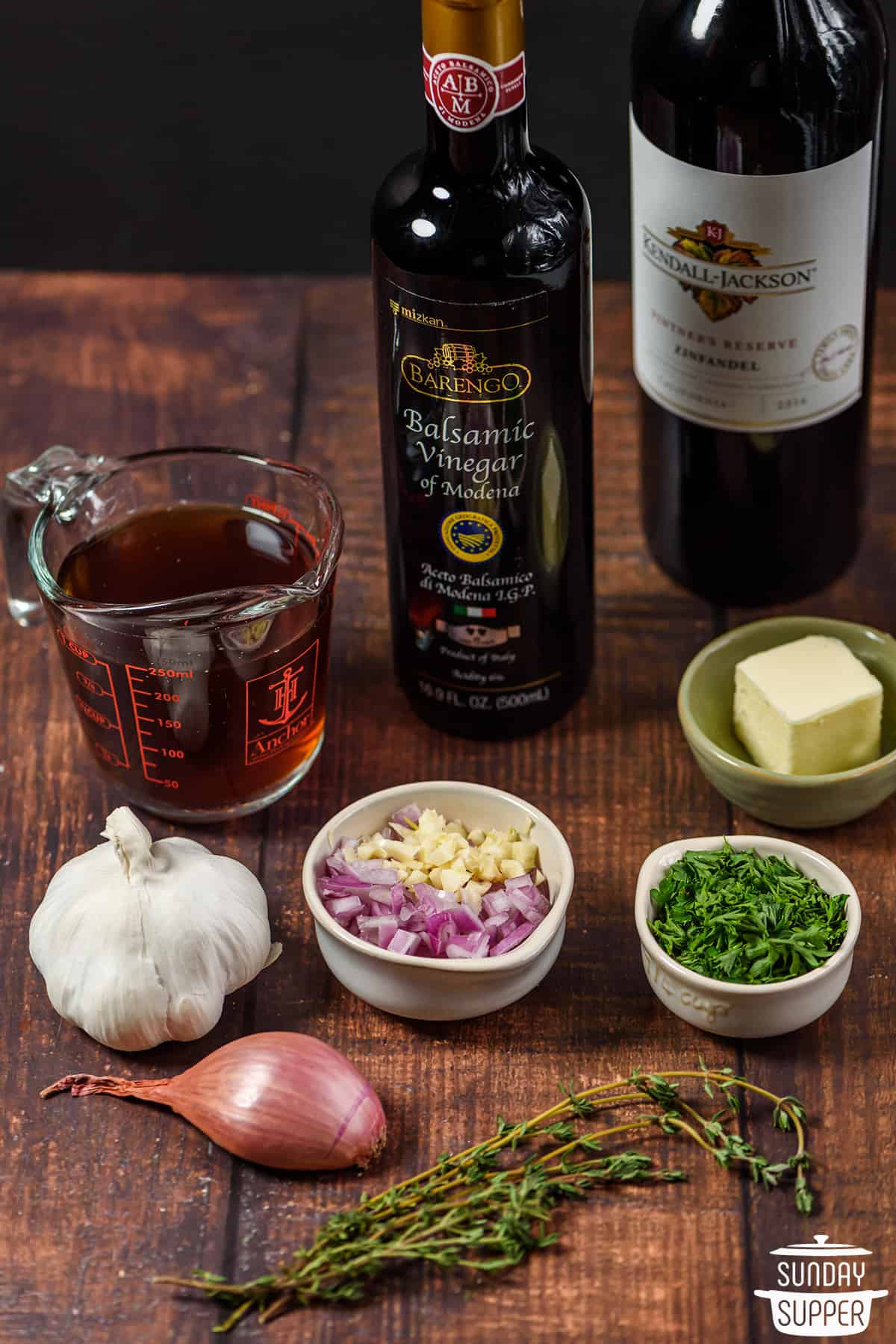
How to Make Red Wine Sauce for Steak
- If preparing a pan-seared steak, reserve 1 Tablespoon of the drippings from the steak in the pan. If not, melt 1 Tablespoon butter in a cast-iron skillet or saucepan over medium heat. Add garlic and shallots, and saute for about 1 minute until tender and fragrant.
- Add red wine, beef stock, balsamic vinegar, and thyme. Raise the temperature to medium-high heat and bring the mixture to a rapid simmer.
- The wine sauce will begin reducing and will thicken gradually in 3-5 minutes.
- If using fresh thyme sprigs, remove them from the sauce. Turn the heat to low and whisk in additional butter. Let the liquid simmer further.
- Add parsley, taste, and add additional salt and pepper if desired. Serve, and enjoy!
Red Wine Sauce for Steak Expert Tips
- I recommend using a high-quality drinking wine for red wine sauce, rather than a cooking wine.
- Red wine vinegar won't work as well in this recipe, so use chicken or beef stock if you want to avoid using wine.
- If you don't have pan drippings, use butter as a replacement for the fat.
Wine Reduction Sauce FAQ
If your sauce broke, it means it may have heated too quickly. If it starts to separate, remove the pan from the stove and quickly mix together until smooth before returning to the heat.
You can make this sauce without wine by substituting beef stock for the wine, or use an alcohol-free red wine.
Great additions to red wine sauce include carrots, mushrooms, or sliced red onions (rather than shallots).
Storing Red Wine Sauce
Store leftover red wine reduction in an airtight container in the refrigerator for up to 4 days. Alternatively, you can also freeze it for up to 6 months, as long as the container has at least half an inch of space at the top to account for liquid expansion. Make sure to label with the freezing date.
Reheating Red Wine Reduction
Reheat red wine sauce by adding it to low heat over the stove, slowly bringing it back to temperature and occasionally stirring.
Try my Easy Béarnaise Sauce or Homemade Balsamic Glaze next!
Reduction Sauce for Steak
Although this is one of the best steak sauces, you can use red wine reduction for more than just steak, too! Try serving red wine sauce with roasted chicken and a side of garlic potatoes, with your favorite Sunday pot roast, or even with grilled lamb. I know you'll enjoy every bite!
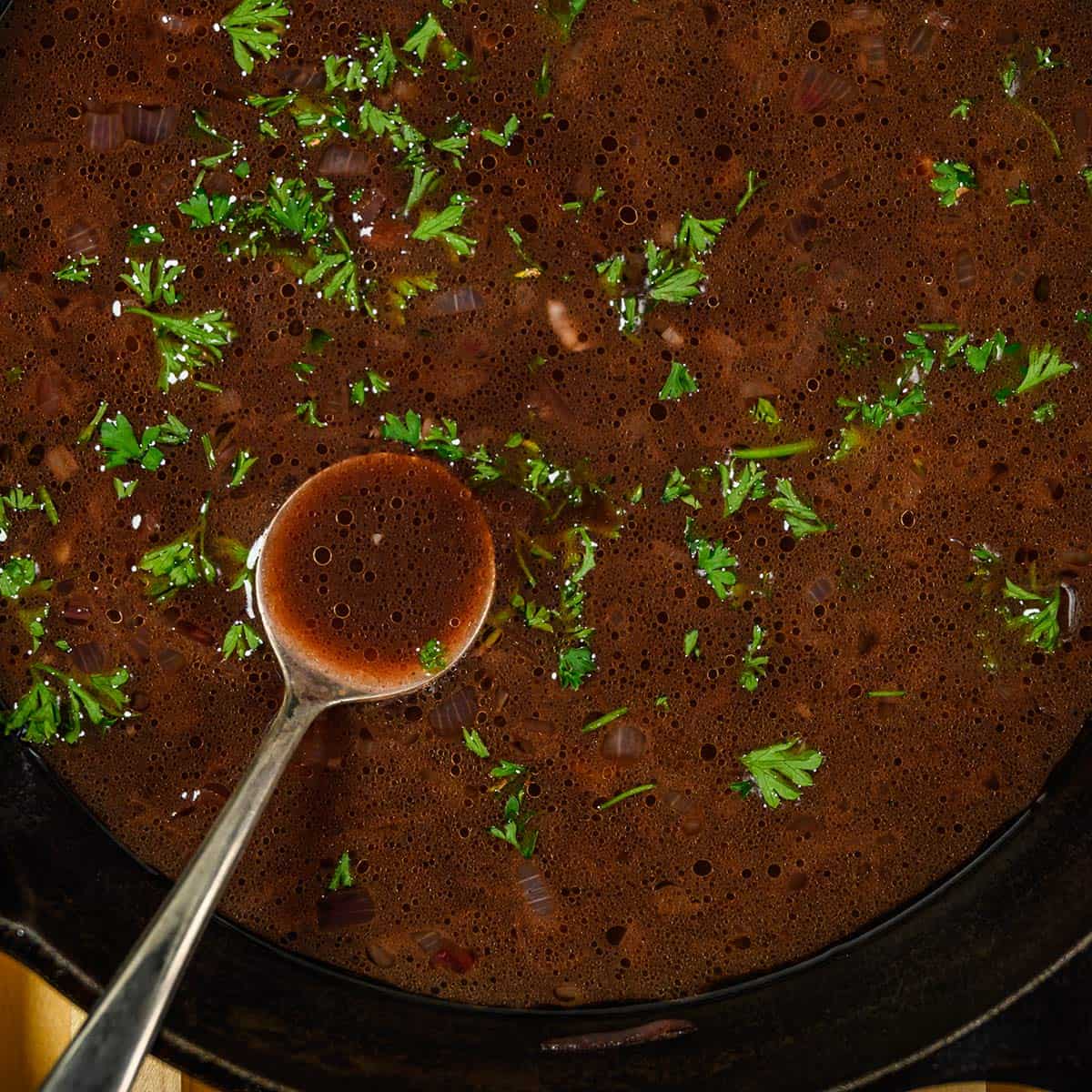
Red Wine Reduction
Ingredients
- 1 Tablespoon drippings from steak - or 1 Tablespoon butter, if you have no drippings
- 1 Tablespoon minced garlic - or garlic paste
- ¼ cup minced shallots - or red onions
- 1 cup red wine - your choice, or equal amounts beef stock if not using wine
- 2 Tablespoons balsamic vinegar
- 2 sprigs fresh thyme - plus more for garnish
- 1 cup beef stock
- ¼ cup roughly chopped parsley leaves
- 2 Tablespoons butter
Instructions
- If preparing a pan-seared steak, reserve 1 Tablespoon of the drippings from the steak in the pan. If not, melt 1 Tablespoon butter in a cast-iron skillet or saucepan over medium heat. Add garlic and shallots, and saute for about 1 minute until tender and fragrant.1 Tablespoon drippings from steak,1 Tablespoon minced garlic,¼ cup minced shallots
- Add red wine, beef stock, balsamic vinegar, and thyme. Raise the temperature to medium-high heat and bring the mixture to a rapid simmer.1 cup red wine,2 Tablespoons balsamic vinegar,2 sprigs fresh thyme,1 cup beef stock
- The wine sauce will begin reducing and will thicken gradually in 3-5 minutes.
- If using fresh thyme sprigs, remove them from the sauce. Turn the heat to low and whisk in additional butter. Let the liquid simmer further.2 Tablespoons butter
- Add parsley, taste, and add additional salt and pepper if desired. Serve, and enjoy!¼ cup roughly chopped parsley leaves
Notes
- I recommend using a high-quality drinking wine for red wine sauce, rather than a cooking wine.
- Red wine vinegar won't work as well in this recipe, so use chicken or beef stock if you want to avoid using wine.
- If you don't have pan drippings, use butter as a replacement for the fat.



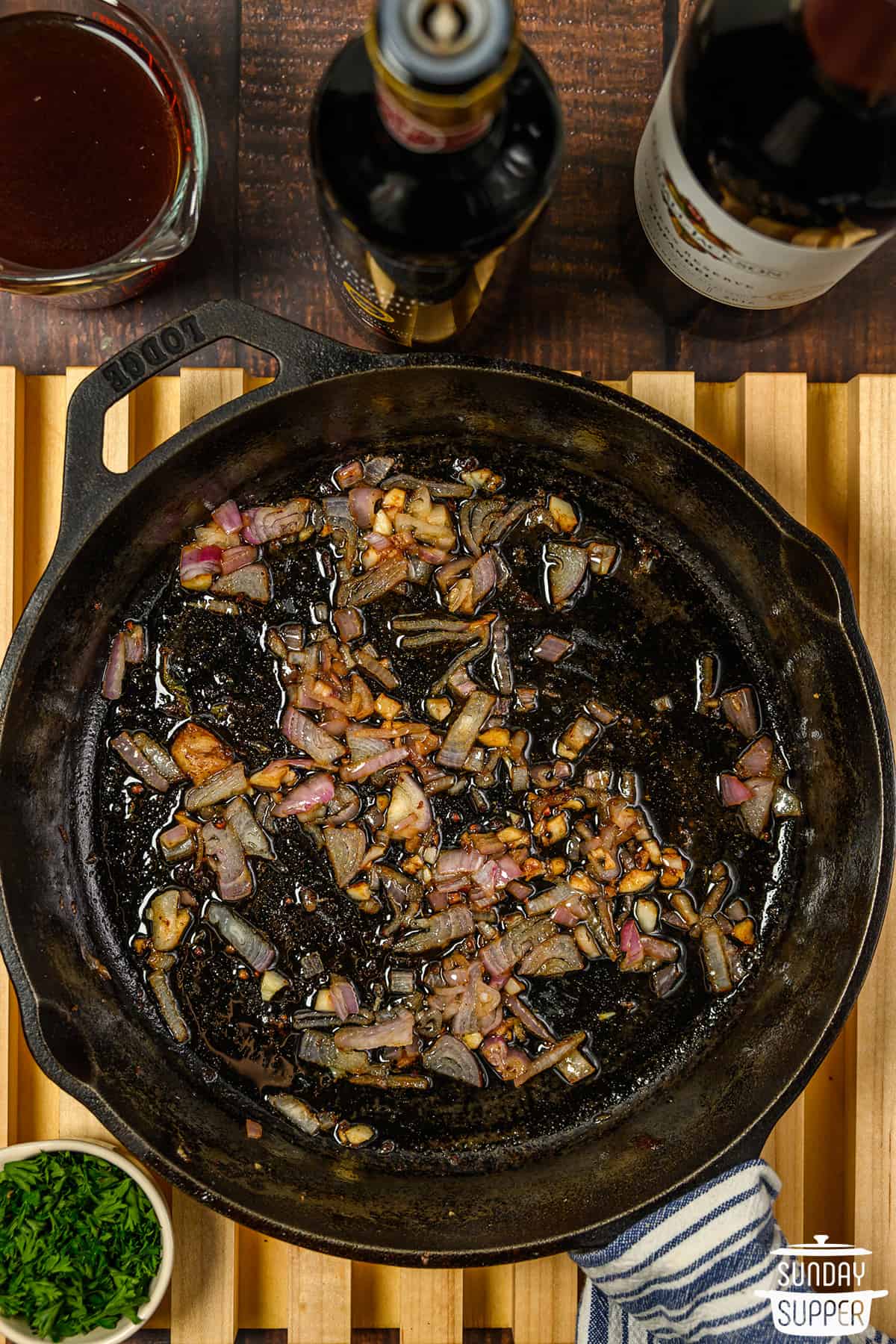
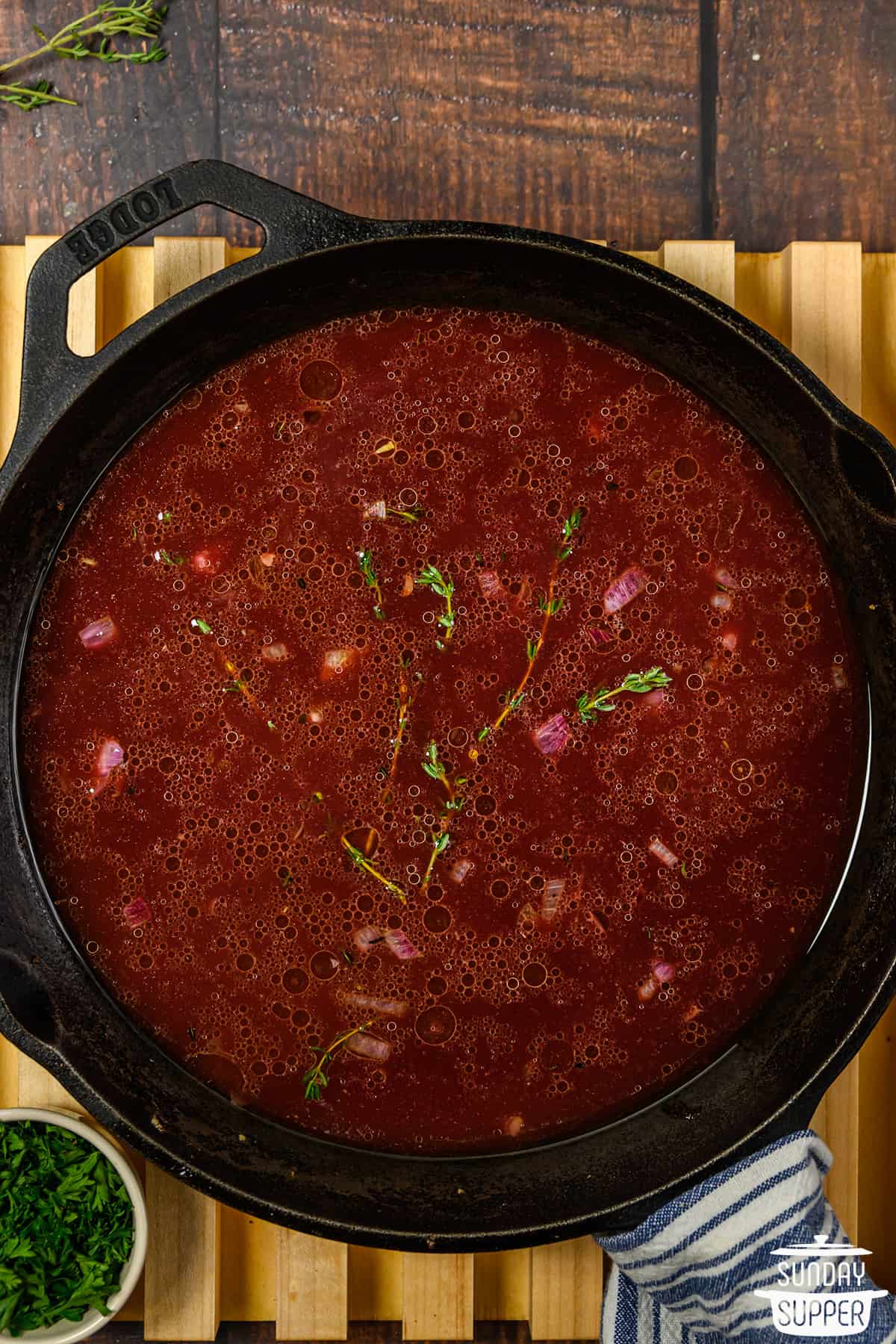
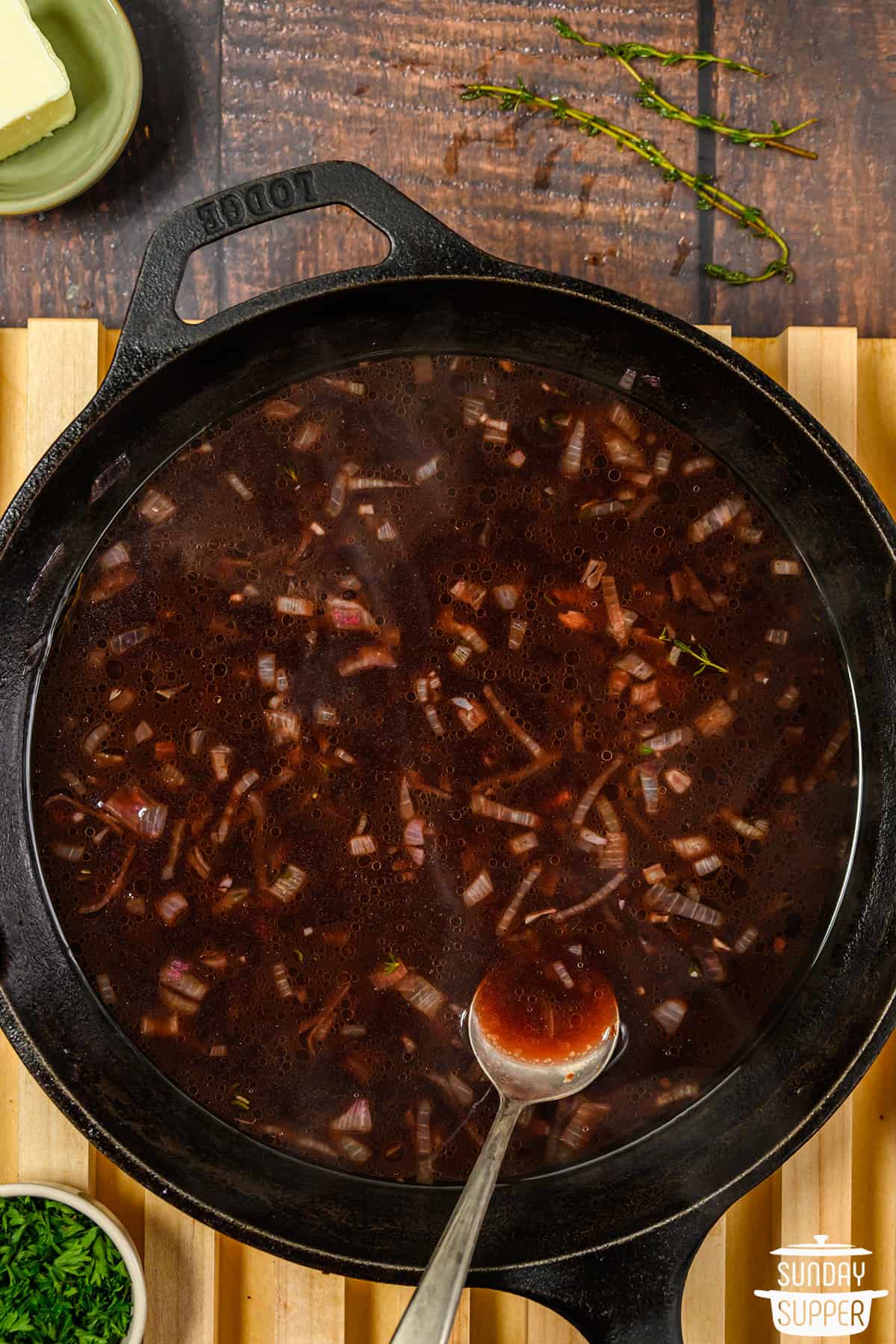
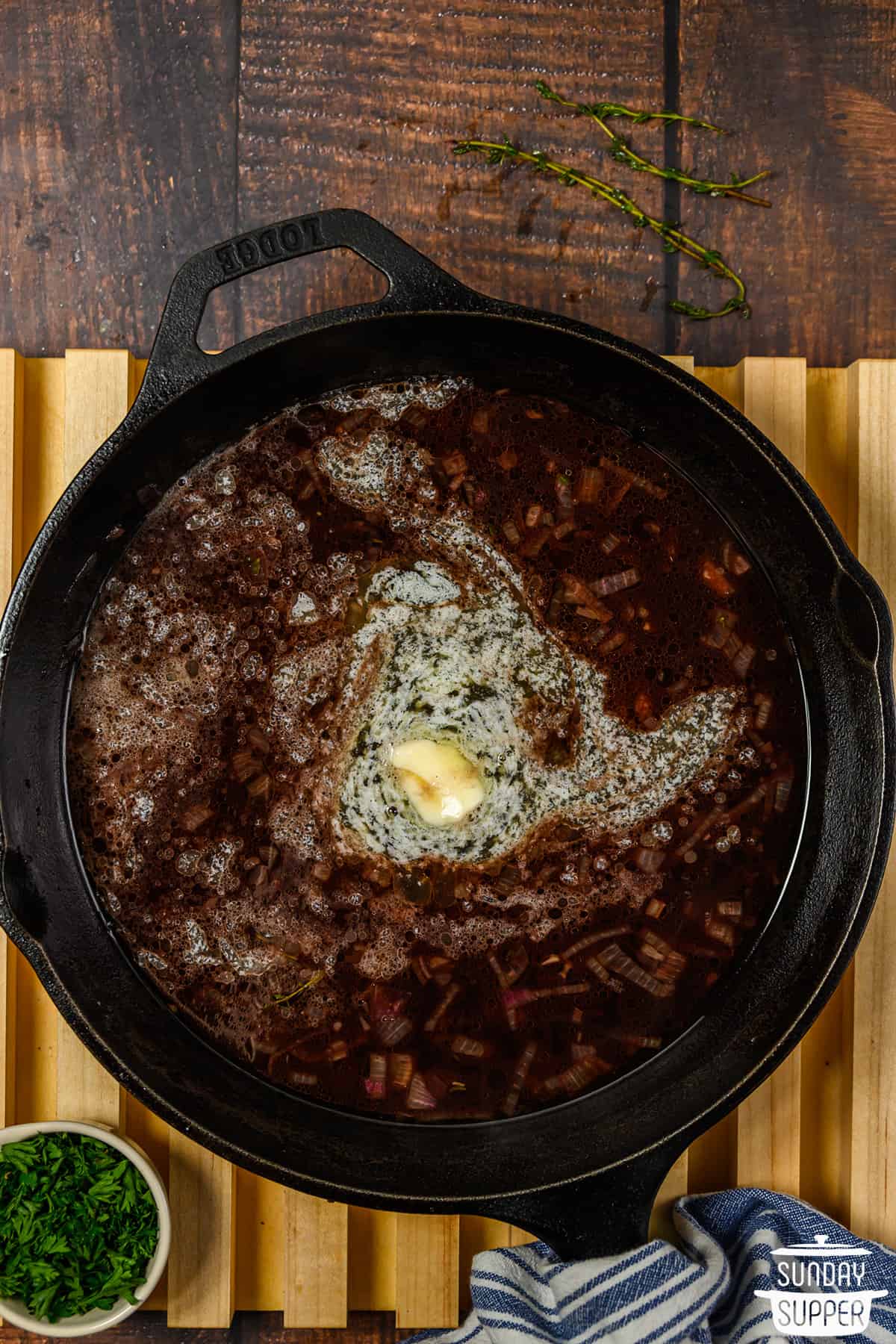
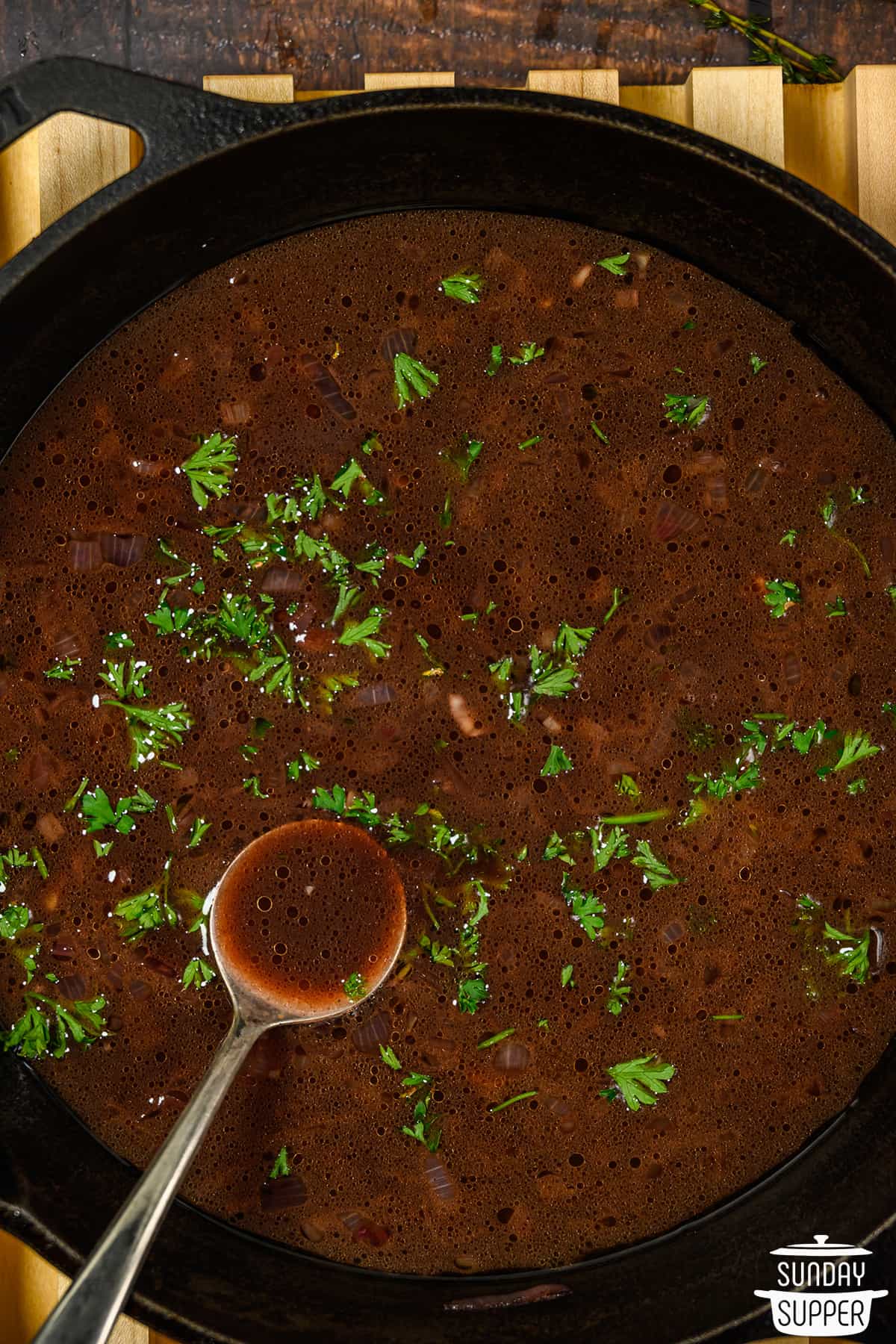
Tay says
This worked exactly as written, thanks!
Isabel Laessig says
So glad you enjoyed it, Tay! Thank you!